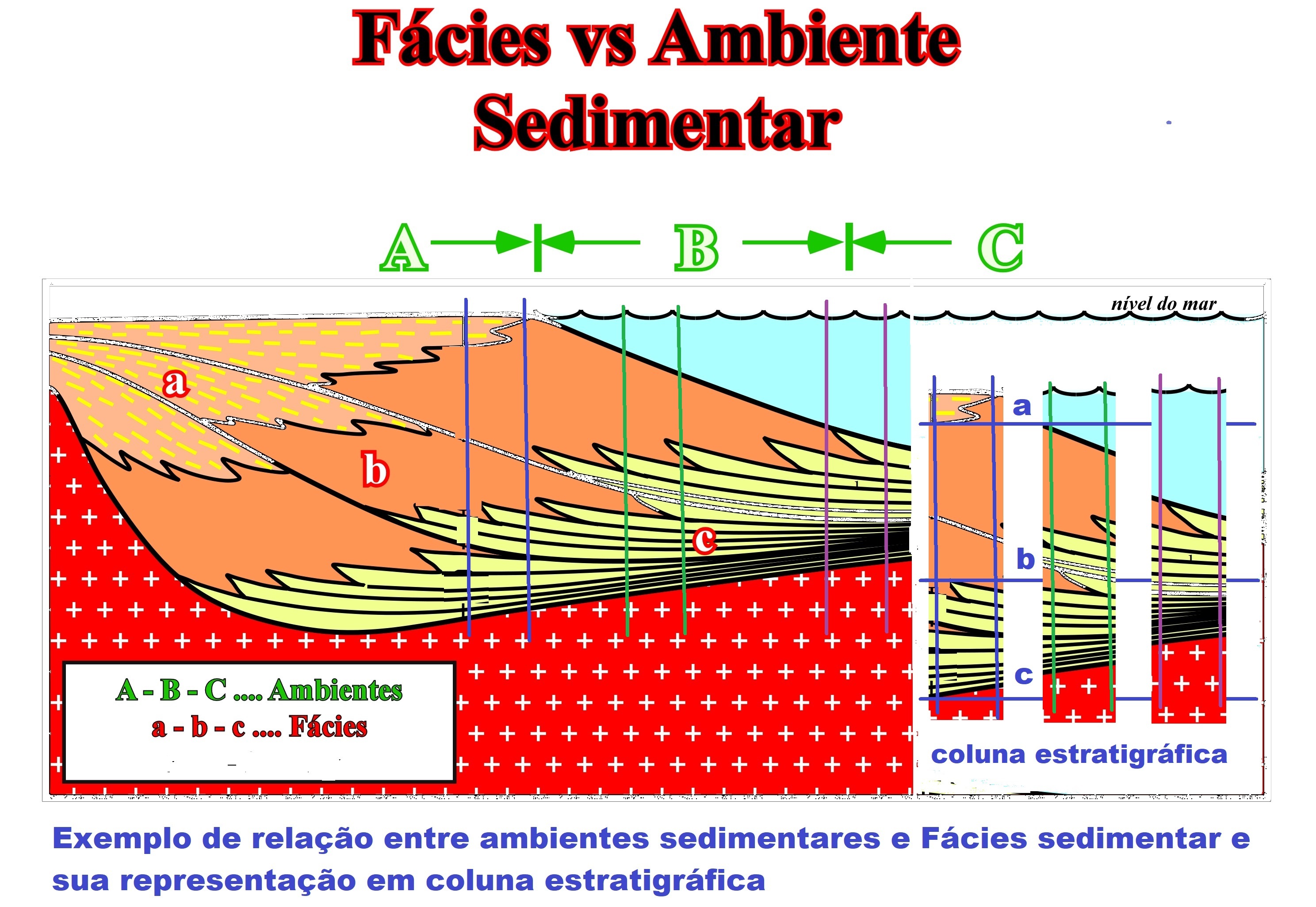
A Estratigrafia é um ramo da Geologia que tem como objeto de estudo as rochas sedimentares correlacionando a sua forma de deposição, empilhamento e geometria bem como a idade relativa ou absoluta de cada unidade sedimentar. A característica fundamental das rochas sedimentares é a sua natural predisposição para se depositarem em camadas sobrepostas obedecendo ao estrito princípio da horizontalidade. As camadas também se designam estratos, constituindo a sua deposição em horizontalidade o processo de estratificação em si.
Uma metodologia chave num quadro de análise que pretenda descrever um regime estratigráfico, é a capacidade de agrupar ou classificar o conjunto de feições que integram esse regime:
FÁCIES SEDIMENTAR:
Designa-se por FÁCIES (palavra de origem latina que designa o “aspecto” ou “aparência de algo”), ao produto da deposição num determinado ambiente sedimentar e que, por essa via, lhe confere certa homogeneidade que a distingue das restantes. FÁCIES sedimentar é assim um determinado volume de sedimento que apresenta características inerentes ao ambiente sedimentar em que ocorreu. Podem ser definidas, entre outros, com base na litologia (ramo da Geologia que estuda a génese, a composição e propriedades das rochas) , na textura ou granulometria, na geometria posicional, espessura ou presença de fósseis.

A EARTH CACHE:
É de fácil descodificação e apenas pretende chamar a atenção para a estratigrafia e o conceito de FÁCIES: O GZ situa-se em pleno território da bacia lusitânica e representa uma paisagem costeira muito rica na observação deste fenómeno (para mais detalhes sobre a génese da formação destas estruturas sedimentares aconselhamos a GC64K9B).
Após o curto percurso no estradão de acesso ao quartel, detém-te assim que estiveres alinhado com o sinal de Parque à tua direita e de Mobilidade Condicionada à tua esquerda.
Observa com atenção um ou outro lado do talude à tua escolha e imaginariamente, desenha um retângulo que vá da base ao topo com cerca de 1mt de largo: desta forma delimitas o teu território de observação e crias a tua própria versão de uma coluna estratigráfica.
O teu log será bem muito bem-vindo mediante as respostas corretas às questões abaixo via mail que consta do perfil.Não esqueças que de acordo com a alteração das guidelines (Jun. 2019), além das respostas, o teu log só será válido com o envio de uma foto comprovando a tua presença no local que pode ser do teu gps, nick escrito num pedaço de papel ou algo similar:
1. Incluindo os sedimentos não coerentes no topo do talude (areia solta), e que darão testemunho do recente Quarternário Geológico, quantos mais FÁCIES consegues identificar?
2. Na tua opinião, quais as características litológicas que melhor as diferenciam? A espessura? a presença/ausência de fóssies? a Geometria, ou a textura e a granulometria?
Obrigado pela tua visita e esperamos que tenha sido "fácies"...!
/p> 
SEDIMENTARY FACIES
Stratigraphy is a branch of geology whose object is to study sedimentary rocks by correlating their form of deposition, stacking and geometry as well as the relative or absolute age of each sedimentary unit. A main characteristic of sedimentary rocks is their natural predisposition to deposit in overlapping layers obeying the strict principle of horizontality. The layers, also named strata and its natural horizontal deposition, is the stratification process itself.
A proper methodology for a framework of analysis aimed to describe a stratigraphic regime ought to consider the ability to group or classify the set of features present in a certain sedimentary scenario:
FACIES is a Latin word meaning “appearance of something”. Transported to the geological context, sedimentary FACIES means that the product of deposition in a given sedimentary environment will shift if a different sedimentary environment is considered. Sedimentary FACIES may, therefore be considered a certain volume of sediment that presents characteristics inherent to the sedimentary environment in which it occurred. Among others, FACIES may be studied based on lithology (branch of Geology that studies the genesis, composition and properties of rocks), texture or grain size, positional geometry (tectonics), thickness or presence of fossils (maybe it will help to observe the listing image that ilustrate sedimentary environments and Facies).
THE EARTH CACHE:
We hope it is easy to decode since the EC only aims to draw attention to stratigraphy and the concept of FACIES:
The GZ is located in the territory of the Lusitanian basin and represents a very rich coastal landscape for the observation of this geological setting, which you may find more deeply explored by visiting the nearby GC64K9B.
Please go through the short access route towards the main gate of the Military barracks and hold your steps as soon as you find yourself aligned with the blue sign of “Parking” on your right, and the sign “Reduced mobility” on your left. Now look closely at either side of the slope of your choice, and imagine a rectangle from top to bottom about 1m in width: this way you delimit your territory of observation and create your own version of a stratigraphic column.
Your log will be very welcome once you replied correctly to the questions below via email that appears in the profile. Be aware that according to the recent alteration of the guidelines (Jun 2019), appart from the correct answers to the questions, your log only becomes valid by posting a photo that provides evidence of your presence at the GZ::
- Including the non-coherent sediments at the top of the slope (loose coarse sand), which gives testimony of the recent Geological Quarternary, how many more FACIES can you identify?
- What is the thickness of the lower Facies?
We appreciate your visit and hope you find it easy and somehow educational.